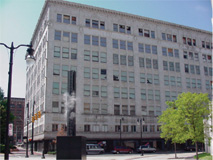

And the Pizitz, Finally
The last of Downtown’s iconic buildings slated for conversion is the former Pizitz, a family-run department store built in 1923. Remaking the eight-story, 225,000-square-foot landmark would be the City Center’s single largest residential redevelopment project. Sloss Real Estate’s Ferguson says his company is looking to put as many as 100 loft condominiums and possibly some ground-floor retail stores in the white terra-cotta façade building. He didn’t give many details about Sloss’ costs, saying that the company was still working out a deal to buy it from Bayer Properties. Jill Verdeyen Deer of Bayer Properties said her firm specializes in commercial and retail development. So the firm decided to sell the Pizitz after other new buildings Downtown lessened the demand for high-end office space. But Bayer had difficulty finding the right partner to convert the landmark for residential use. “The building is important to us, so it was important that we found a company that was going to do a good quality product,” Deer says. “We were approached by Sloss Real Estate Group late last year, and felt confident in their ability to do this project.” Sloss Real Estate is a partner in another significant Downtown development, Park Place. The $100 million-plus mixed-income neighborhood will eventually have 581 rental apartments and 56 townhouse condos on six blocks where the former Metropolitan Gardens housing projects once stood. What the Future Holds And the biggest non-residential conversion will remove yet another major blight from the City Center landscape, he says. The City of Birmingham recently agreed to put in half of $3 million with the Entrepreneurial Center to buy the vacant two-story, 167,000-square-foot Sears Building, near the Cabana. Run by Calvert’s wife Susan Matlock, the Center will bring under one roof its business incubator and the UAB’s high-tech business incubator, the Office for the Advancement of Developing Industries (OADI). “All of these things are related,” Calvert says. “As we get more housing Downtown, more investments, more businesses, more retail stores – we’ll see more interest from developers. I’m just delighted to see this kind of snowball effect.”
“There’s a prediction by 2009 to have 2,500 residential units Downtown. We’re halfway there, and with all the development, that’s going to be an easy target to hit. So, I’m just really pleased with what’s going on in our City Center, really pleased.” Kincaid says he’s not yet concerned about gentrification, that the hot market for loft developments will drive rents and property taxes up so high that they will price lower-income residents out of the City Center. He’s more concerned about Downtown reaching a critical mass of people, that tipping point where the right number of people will attract retail stores such as an urban-style grocery store that Wal-Mart has developed. Once that number is reached, Kincaid says, “the drug stores will come, the grocery stores will come, the movie theaters, and the restaurants will come. So life will come back to the City Center. We won’t have to roll up the sidewalks at night.” Visit www.leercorp.com/leertower.htm and www.CityFederalCondos.com for more information about those developments. Also visit www.BirminghamView.com for an updated listing of loft developments. |
|
SUBSCRIBE l ABOUT US l FEATURES l PERSPECTIVES l LATEST VIEWS l COMMUNITY CHEST Website
Development: Deidre Ali Creative
Services, LLC |


